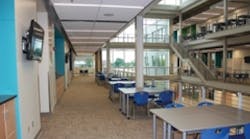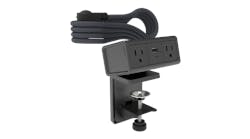With all of the hype that green building is receiving throughout the school facility-management industry, it’s easy to overlook some elements that may not be right in front of a building manager’s nose. It is helpful to examine the role floor covering plays in a green building project.
Flooring is one of the most significant and important systems in an educational structure. However, regardless of the quality of the floor covering, the real worth of sustainable carpet, vinyl, linoleum, wood, ceramic or tile will be maximized and provide a return on investment if installed by a professional who understands the green building process.
In fact, by specifying the qualifications of the floor-covering professional as well as the flooring products, a school facility manager can contribute to the accumulation of LEED points for both new construction and existing buildings via LEED’s operations and maintenance categories.
Did you know that products and installation materials contribute to LEED in seven of nine categories, and four of those seven areas encompass flooring? Flooring plays a LEED role in Indoor Environmental Quality (IEQ), Materials and Resources (MR), Innovation and Design Process (IDP), and Regional Priority. Flooring can help with LEED points in the categories of new construction, major renovation, existing buildings, commercial interiors, schools, retails, healthcare and homes.
Picking Products Wisely
To gain MR credits, look for products high in recycled or rapidly renewable content such as recycled rubber, carpet fibers or cork. MR credits are available if the product is made locally or regionally, meaning materials used to make the flooring are extracted, harvested or manufactured within 500 miles of the job site. A project may capture an MR point if 2.5 percent of the total value of the building materials is made from rapidly renewable materials, which include plants typically harvested in a 10-year cycle. The type of flooring may help a project reach that threshold. Common substances that are considered rapidly renewable include cork, linoleum and bamboo.
IEQ credits are found by selecting adhesives, solvents and carpet systems that meet established air-quality standards. The South Coast Air Quality Management District’s (SCAQMD) Rule #1168 dictates volatile organic compound (VOC) content limits, and a project that keeps within those limits can earn another LEED point.
To gain another LEED point for flooring systems, carpet and cushion systems must meet Carpet and Rug Institute Green Label program parameters; hard-surface flooring must comply with the FloorScore standard. Wood floor finishes also must meet requirements under the SCAQMD Rule #1168.
In the world of carpet, capturing LEED points is possible in a variety of categories. As an example, take a look at new construction MR. Carpet LEED points can be accomplished by focusing on reuse, such as mandating the use of existing interior nonstructural floor-covering elements in at least 50 percent of the completed building. The premise is to extend product life cycles, conserve resources, retain cultural resources and reduce waste.
Up to two points are available under new construction MR if the project diverts construction and demolition debris from disposal in landfills and incineration facilities. This incentive is meant to redirect recyclable recovered resources back to the manufacturing process and reusable materials to appropriate sites. Building managers can help work toward LEED points regarding the use of carpet by mandating the recycling or salvaging of nonhazardous construction and demolition debris, and establishing goals for diversion from disposal in landfills and incineration facilities and adopt a construction waste management.
Still another one to two points can be received in the MR section if flooring materials are products that are reused. Salvaged, refurbished or reused materials should constitute at least 5 percent of the total value of materials on the project. Materials with recycled content that makes up at least 10 percent of the cost of the project materials also help capture LEED points.
Wood products have received much attention lately, thanks to import issues from China. For LEED credits, points are available to encourage environmentally responsible forest management. In just one of several criteria dedicated to wood, LEED parameters require using a minimum of 50 percent (based on costs) of wood-based materials and products that are certified in accordance with the Forest Stewardship Council’s principles and criteria for wood building components.
The FloorScore Program
A number of certifying and standard-setting organizations provide support for and complement the LEED program.
The U.S. Green Building Council has approved hard-surface flooring products certified by the FloorScore program as an alternative compliance path to achieve LEED credits for new construction. Developing the FloorScore program is the Scientific Certification System (SCS) a credible third-party testing, evaluation and certification system for indoor air quality performance.
Also assisting in the FloorScore program is the Resilient Floor Covering Institute (RFCI), which also acts as a flooring products certification program focusing on indoor air quality.
Laying a Strong Foundation
Proper installation of a sustainable flooring product is essential to reap the benefits that the LEED system is intended to deliver. Because of that, flooring installation contractors are playing a more vital role for specifiers and building managers because of their knowledge of flooring products, and how the installation process affects eligibility for LEED points. Contractors, in return, are relying on their workers to stay abreast of changes in the green building industry. And that’s where training becomes crucial.
A green floor’s performance will reflect how well the building manager and construction team married product specification and installation requirements.
The best green product in the world will be useless if installed improperly, or without regard to adhering to LEEDs exacting standards. Therefore, it does matter who installs the floors. A mechanic without the knowledge of VOC emissions of open adhesives, for instance, can invalidate a LEED application for indoor air quality.
To shield a LEED project from unnecessary loss of points, facility managers should require that the flooring contractor use trained, certified crews. A flooring contractor needs to be competent and have well-trained installers before they begin the job. One way to ensure this is through detailed specification. Mandate that the flooring materials are installed by a certified professional. That specification still keeps the project open to dozens of prospective, qualified contractors; at the same time it weeds out poorly trained, ill-qualified, less reputable or less-equipped outfits.
Here is suggested language for various sections of Division 09 of the Master Specification program, including 096000 Flooring, 096100 Flooring Treatment, 096200 Specialty Flooring, 096400 Wood Flooring, 096500 Resilient Flooring, 096700 Fluid-Applied Flooring and 096800 Carpeting:
•Part 1-General: Quality Assurance. Installers shall be skilled tradespeople enrolled in a state-approved apprenticeship program, or certified by a training and certification program supported by the product’s manufacturer. Key attributes of the training program must include: Four-year (minimum) apprenticeship program, totaling 160 hours per year; career-long training; manufacturer-endorsed training; and fundamental journeyman skills certification.
By using the above specification, institutions can ensure that installers handling flooring materials have the training, skills and experience to carry out any project’s plans.
McGrath is director of the International Standards and Training Alliance (INSTALL), Haddonfield, N.J. He can be reached at [email protected].



